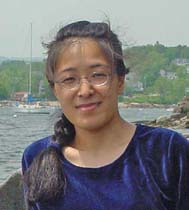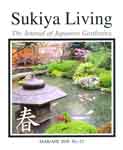|
Travel to Japan
Traveling to Japan is something that many Sukiya
Living enthusiasts have enjoyed or hope to enjoy in the future. We asked a
few experienced travelers and professional guides to comment on the subject.
Here’s what they had to say when we asked them:
"What advice would you offer a Sukiya Living enthusiast who is planning
to visit Japan?"
 Tamao
Goda
Tamao
Goda
In the past ten years I’ve guided more than 100 Westerners on their
first trips to Japan. There’s no doubt that Japan is a very difficult place
to travel, especially on your first visit. Most of the problems I’ve
observed are language-related, but there are plenty of cultural stumbling
blocks too. The problems are multiplied the farther you get from major
cities, and the farther you stray from typical tourist circuits within those
cities.
Because of these challenges, I recommend that you travel with a “gourmet”
tour group that is focused on gardens and architecture. The advantages of
this approach are numerous.
Because your guides already know how to navigate and maneuver, you’ll end up seeing twice as much as you would by yourself. The garden sites you visit will be of higher quality. Even the food will be better, and of course if you have any problems there will be someone there to help you.
What I’m recommending is a quality tour, not the typical “bus tour”
packages that are put together by big agencies. If a generic bus tour is
your only option you are better off going it alone. Don’t waste time
studying travel guidebooks and internet sites because they’re filled with
misinformation. JOJG’s Shiosai Rankings are a better way to prioritize your
trip. I recommend that you stay away from temples and shrines, and instead
try to experience “the real Japan.” Don’t miss the more intimate spaces that
can be found at villas, restaurants, and ryokans.
Tamao Goda is JOJG’s Art Director and chief Japanese-language researcher.
 John
Powell
John
Powell
Preparation is the key to any successful trip. While the temptation
to visit the tourist landmark gardens is great, to truly understand the
Sukiya Living Environment your trip should focus on destinations that allow
you to comfortably enjoy the gardens from inside a house, inn, restaurant,
or from an outbuilding such as an azumaya. JOJG’s Shiosai Rankings (see JOJG
#58) continually update the best sukiya environments throughout Japan and
are a valuable tool when planning your trip.
Learning at least a little Japanese will make the trip easier and more enjoyable. The farther away you travel from the main tourist centers, the less English assistance is available. Language skills will also help you meet people and learn some things about their lifestyles.
Visiting private gardens is always a delight, but without an invitation
you should politely view them from a distance. A nice option is to stay in a
traditional ryokan inn with a garden. This allows you to live in the sukiya
style if only for a few days or weeks.
John Powell has trained in Japan and is a garden builder in Weatherford,
Texas.
 Steve
Beimel
Steve
Beimel
There are three ways to experience sukiya-style Japan: join a
commercial tour, hire someone to create a private tour for you, or create
your own.
The best garden-focused tour available is the JOJG Garden Tour. If you hire someone to create a trip for you, look for a JN garden expert/professional tour planner. Unfortunately, we are few in number. You can certainly create a “pleasant” journey for yourself, but don’t expect consistent, quality experiences. Little good information is available on-line. Most guidebooks are not geared to gardens. However, I do recommend “Guide to the Gardens of Kyoto,” by Treib & Herman.
Stay a night at an exceptional Japanese inn with traditional,
Japanese-style buildings with gardens. Remember, you get what you pay for.
Have a few meals at a Japanese-style restaurant set in a sukiya-style
structure. Besides Kyoto and Nara, try visiting an “old town” district in
such places as Kakunodate, Gujo Hachiman, Uchiko, and Hagi for a quiet
Sukiya Living experience.
Steve Beimel, retired tour company president, leads small group tours in
Japan.
 Pavel
Cihal
Pavel
Cihal
A week ago we returned from Japan. In five weeks we visited 30 towns
and villages and a total of 90 gardens. To “cover ground” like this in Japan
is not easy. We recommend making a good plan before departure. Surely you
should buy a Japan Rail Pass, because it saves a lot of time and money. The
Rail Pass means you will pass by many railway Information Centres. We’ve
found the staff at those Centers to be very helpful.
There are great things to see all over Japan. We recommend you skip Tokyo and instead go to rural places such as Shimane Prefecture, home of Japan’s No. 1 garden, The Adachi Museum of Art. Another great out-of-the-way place is Kanazawa, which has a fine craftsman tradition as well as some nice gardens.
In Kyoto you can see many gardens, but there are a lot of tourists. We
recommend day trips out of Kyoto to see spots such as Hikone and Himeji.
Also try to visit some of the rural mountain villages north of Kyoto. If you
are a Sukiya Living enthusiast you will feel the difference.
Pavel Cihal and his wife Romana build Japanese Gardens in the Czech
Republic.
 Adrian Bennett
Adrian Bennett
Study: Before you go to Japan study Japanese. Even a limited
knowledge can be useful and may eventually result in making friends in Japan
and getting access to their homes and to places most tourists never see. But
also study the history, arts, and literature of the country, including tea
ceremony, ikebana, theater, visual arts, and architecture. And of course
read widely on the gardens themselves.
Network: Seek out Japanese organizations in your area as a way of meeting people, both Japanese and Westerners, who have knowledge and interest in the culture, and who can connect you to people in Japan.
Broaden Your Experience: Visit both the important cultural centers of
Tokyo and Kyoto, but also try to see some other parts of the country. For
example, take the train to Shimane Prefecture and see the countryside on the
way. Spend a day at the Adachi Museum, and stay in a nearby country inn. You
can also see an interesting variety of other gardens in the area.
Adrian Bennett is a Japanese garden researcher from Brooklyn, New York.
 Tony
Bishop
Tony
Bishop
I recommend a one or two-week Japan Railpass. It’s good on the
Shinkansen bullet train and is the best way to get between major cities.
Many, but not all, of the local trains and buses also accept it.
Near your destination I’ve found taxies to be very convenient. The taxi drops you right at the door. The drivers are honest, rates are reasonable, and there is no tipping. Plus, unlike the subway, you can see local scenery along the way.
For eating I recommend you trust the locals. Avoid the $200 dinners and instead try out noodle shops and neighborhood restaurants. The menus are usually posted, sometimes with plastic models of the food. You can select an item and eat affordably. Don’t dismiss the pre-packaged meals at the convenience stores, either.
Knowing a little Japanese helps, but be sure to take a notepad & pen with
you. Many Japanese can read and write in English, and can respond to written
questions with written answers in English. The people are shy, but kind, and
will help you in many often unexpected ways.
Tony Bishop is the owner of Sun Garden Specialties, in Tulsa, Oklahoma.
 Asher
Browne
Asher
Browne
For a rewarding experience I recommend you avoid popular tourist
destinations such as temples. You and a hundred or so other tourists will be
viewing those sites with history in mind - interesting, but totally
irrelevant. Instead, seek out Sukiya environments where Japanese people go
to eat, sleep, relax, and perhaps shop.
Try going to an elegant restaurant like Ganko Sushi in Kyoto. There you’ll be able to have a great meal while looking out at a wonderful garden. Then stay a night at a classic Japanese Inn to really absorb the Sukiya Living Environment. The best rooms will look out onto an intimate garden. You’ll be served a memorable meal, relax to a cup of tea or sake, and get a good night’s sleep - all in the privacy of your own sukiya-style room.
Other worthwhile places might include shops or cafes located in renovated
buildings. All of these places will put extra care into creating a special
atmosphere with seasonal flower arrangements, lighting, gardens, and of
course great service and an opportunity to make new friends.
Asher Browne lives in New York and builds gardens throughout the
Northeast.
---------------------------------------------------------

